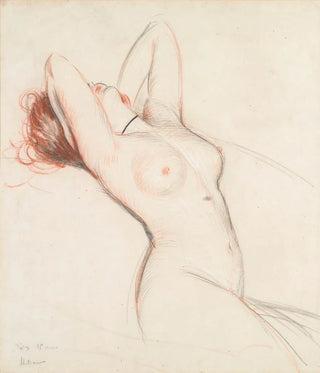Art print | Pas - Paul César Helleu Source: Reproduction | Pas - Paul César Helleu


View from behind

Frame (optional)
Pas - Paul César Helleu – Captivating introduction
In the rich and complex universe of art, certain works stand out for their ability to capture the very essence of human emotion. "Pas" by Paul César Helleu is one of these creations that, through its delicacy and elegance, evokes an intimate and contemplative atmosphere. This piece, imbued with the subtle light of the early 20th century, immerses us in a world where movement and grace meet. Helleu, master of pastel and watercolor, succeeds in transcribing fleeting moments, thus revealing the ephemeral beauty of life. The art print Pas - Paul César Helleu allows us to grasp this artistic magic, offering a window into the fascinating universe of this artist.
Style and uniqueness of the work
Paul César Helleu's style is characterized by a refined and poetic approach. In "Pas," each brushstroke seems to dance across the canvas, creating a visual harmony that captures the eye. The fluid lines and delicate colors blend to form a composition where shadow and light coexist with astonishing ease. Helleu, influenced by Impressionism, infuses his works with an atmosphere of lightness, while maintaining remarkable precision in the rendering of details. This painting stands out for its ability to evoke a moment of life, a pause in time, where the viewer is invited to immerse themselves in personal reflection. The finesse of the strokes and the chosen color palette testify to undeniable technical mastery, making "Pas" both accessible and deeply emotional.
The artist and his influence
Paul César Helleu, born in 1859 in Nantes, is an artist whose imprint on the art world is indelible. Trained at the École des Beaux-Arts in Paris, he quickly developed a unique style that sets him apart from his contemporaries. Helleu is not only a recognized portraitist but also a talented illustrator and engraver. His ability to capture the essence of his subjects, whether elegant women or scenes of daily life, grants him a privileged place in the artistic landscape of his

Matte finish

View from behind

Frame (optional)
Pas - Paul César Helleu – Captivating introduction
In the rich and complex universe of art, certain works stand out for their ability to capture the very essence of human emotion. "Pas" by Paul César Helleu is one of these creations that, through its delicacy and elegance, evokes an intimate and contemplative atmosphere. This piece, imbued with the subtle light of the early 20th century, immerses us in a world where movement and grace meet. Helleu, master of pastel and watercolor, succeeds in transcribing fleeting moments, thus revealing the ephemeral beauty of life. The art print Pas - Paul César Helleu allows us to grasp this artistic magic, offering a window into the fascinating universe of this artist.
Style and uniqueness of the work
Paul César Helleu's style is characterized by a refined and poetic approach. In "Pas," each brushstroke seems to dance across the canvas, creating a visual harmony that captures the eye. The fluid lines and delicate colors blend to form a composition where shadow and light coexist with astonishing ease. Helleu, influenced by Impressionism, infuses his works with an atmosphere of lightness, while maintaining remarkable precision in the rendering of details. This painting stands out for its ability to evoke a moment of life, a pause in time, where the viewer is invited to immerse themselves in personal reflection. The finesse of the strokes and the chosen color palette testify to undeniable technical mastery, making "Pas" both accessible and deeply emotional.
The artist and his influence
Paul César Helleu, born in 1859 in Nantes, is an artist whose imprint on the art world is indelible. Trained at the École des Beaux-Arts in Paris, he quickly developed a unique style that sets him apart from his contemporaries. Helleu is not only a recognized portraitist but also a talented illustrator and engraver. His ability to capture the essence of his subjects, whether elegant women or scenes of daily life, grants him a privileged place in the artistic landscape of his






